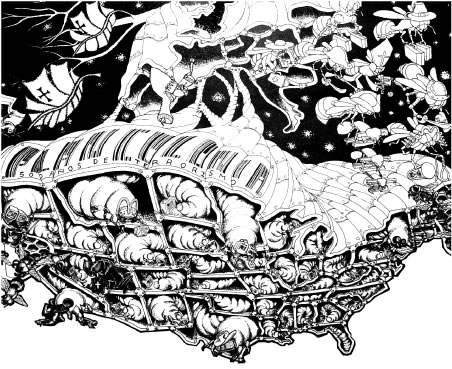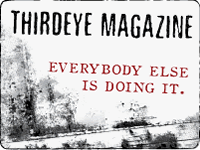
Mural painting, or public art, is one of the oldest and most important forms of artistic, political, and social expression. From prehistoric cave paintings to the frescos of ancient Greece, humanity has demonstrated that art, in its true essence, is a communal enterprise. Picasso used the technique in 1937 to express his intense anti-war sentiment in the masterpiece ‘Guernica’. Mural paintings were used to communicate the political ideals of the Russian Revolution in 1917, and to promote China’s new cultural direction following the 1919 May Fourth Movement. Among the most famous political muralists of the 20th century were the Mexican social realist painters, Diego Rivera, David Alfaro Siqueiros and José Clemente Orozco who portrayed their vision of social justice in the 1920’s through fresco painting. Presently, a group of activists based in rural Eastern Maine known as the Beehive Collective have reinvented this form of visual imagery to create intricate, anti-copyright murals which communicate the dilemmas of corporate globalization.
What started as a stone mosaic project five years ago evolved quickly into a multifaceted, decentralized swarm of worker bees attempting to “cross-pollinate the grassroots.” A few things have set the Beehive Collective apart from other muralists. First, there are no names attached to the work-their pieces are the result of extensive collaboration and meant to be used as self-replicating communication tools. Secondly, their imagery is absent of human beings. In order to avoid creating racially biased depictions of cultures, the bees use flora and fauna unique to the ecosystems that their illustrations represent as analogies for human activity.
Insects such as locusts or wasps are morphed with modern military apparatus, while blood-sucking mosquitoes represent corporations drilling for oil.
Best known for their “graphics campaigns,” or portable mural tours, the Collective has developed posters that convey the struggle of those in the “third world” attempting to survive against the forces of colonialism as well as cultural and ecological destruction. Rendered with the use of ultra-fine rapidograph pens, the posters mimic scientific drawings and old-fashioned clip art. Before ever attempting to depict a certain species, extensive research is conducted to discover how it contributes to its local bioregion. Insects such as locusts or wasps are morphed with modern military apparatus, while blood-sucking mosquitoes represent corporations drilling for oil. In their “Plan Columbia” poster, leaf-cutter ants represent the resistance, streaming up and down the sides of the poster bearing pieces of the “nightmare” they have been dismantling. It isn’t enough for members of the Collective to rehash secondhand sources, so they have conducted hours of interviews with farmers and indigenous people in Latin America to get the story straight.
“The benefit of so-called ‘first world’ privilege becomes abundantly clear when you speak with those who are literally fighting everyday to keep alive their culture and heritage from the onslaught of corporate globalization,” comments one worker bee, “It’s really essential to recognize that the culture which keeps our privilege afloat wears many different masks, and that one of those is the racist system which sees no problem in exchanging the cultural memory and livelihood of entire hemispheres for mono-cropping, for mono-myths.”
Since their first poster, “Resist Biotechnology,” the bees have been hard at work giving presentations around the Western hemisphere. These presentations currently consist of either a sixteen-foot wide banner version of their Free Trade Area of the Americas (FTAA) poster, or a sixteen-foot tall banner version of their Plan Colombia poster. The banners are accompanied by a six-foot tall projected “slide show” that has forty enlargements of scenes from the posters. Presenters take turns narrating through the mural’s details and facts, helping to break down complex issues into smaller, more digestible chunks. 70-150 presentations are given a year, many of them in high schools, and to date more than 55,000 posters have been distributed without being sold in stores.
Currently, the Collective is hoping finish the third part in their globalization trilogy, “Mesoamérica Resiste,” by the end of the year. The newest piece will highlight the massive resistance to Plan Puebla Panamá (PPP), a “development project” designed to facilitate the exploitation of resources in Mesoamérica by transnational corporations. To develop this graphic, a swarm of 10 bees journeyed from Puebla, Mexico to Panamá, gathering stories of resistance from over 180 groups and individuals. These dialogues were recorded and will be available as bilingual radio programs and digital audio archives. The bees still need to raise $18,000 in order to print the poster, and donations can be made through their website. When the trilogy is completed, it will be transformed into a coloring book that teachers will be able to utilize as curriculum. The Collective is also gathering information to create a map of the North American food system.
These international graphic campaigns are only part of what these busy bees have accomplished. In their regional area, they are also making enormous contributions. The Collective is constructing a 400-square-foot stone mosaic out of recycled materials called the “Biodiversity Crossroads Project.” The mosaic, as usual based on the tireless gathering of personal stories, will take eight years to complete-becoming a permanent addition to the exhibition hall floor of the Maine Organic Farmers and Gardeners Association fair-grounds. The project is meant to have a sense of permanence, perhaps outlasting our own civilization, relating the evolution of modern agriculture for generations to come. Classes and instruction in the creation of stone mosaics are offered, and an artist residency program is under development.
Even the Beehive Collective’s “hive” is enigmatic of their motives and activism. In 2001 the bees began the refurbishing of the Machias Valley Grange, which was constructed in 1904 as a cultural organizing center for farmers involved in a movement called the “Patrons of Husbandry.” An outgrowth of the Populist movement, the Patrons-also known as the Grange-began as an attempt to hold off the pressures of corporate monopolies and to keep agriculture local. In the early 1900’s there were over 400 Grange Halls in Maine alone, and unlike other society halls, the Granges sought to include women and the youth in their decision making process. Today the Grange, thanks to the entirely volunteer efforts of the Collective, has been restored to an active community center-hosting free weekly open-mics, concerts, dances, public internet access, films and discussion groups. This August marked the hall’s Centennial celebration.
The efforts of this unique artist collective mirror the style of its work. Meticulous, strategically organized, and self-replicating, the Beehive Collective is doing much more than simply educating the public about globalization and agriculture practices. They are attacking our very notion of modern art by ditching the typical sort of hyper-individualism, and bringing the craft back to its roots as a community activity. Their murals and mosaics have removed ego from the creation process, instead utilizing the medium as a pure insight into the nature of societal issues. Art and politics, as they have been throughout history, are intrinsically and inseparably entwined. Realizing this, the bees are building a cultural legacy through the muralist tradition with the ability to replace the myths fostered in a generation raised by television. This is human expression at its finest.
For more check out: beehivecollective.org





No Comments so far ↓
There are no comments yet...Kick things off by filling out the form below.